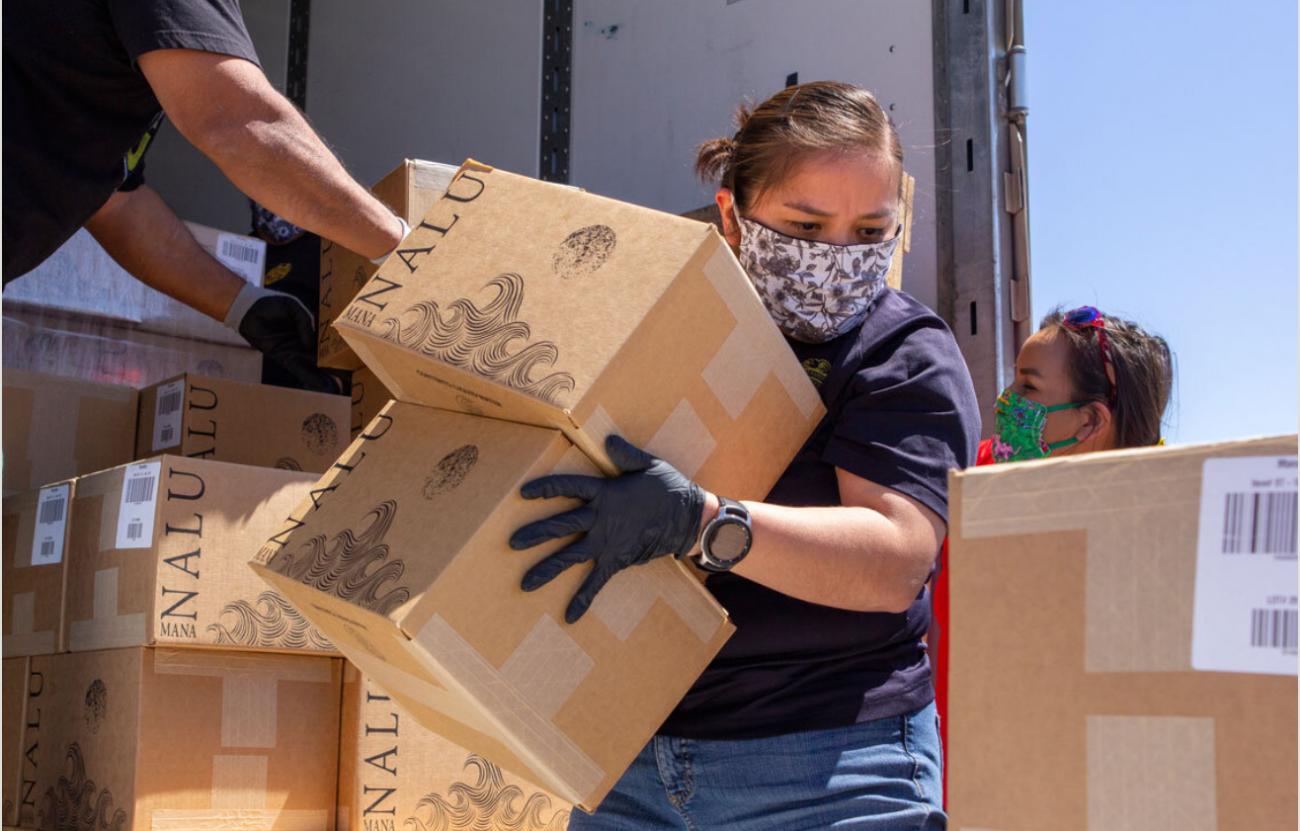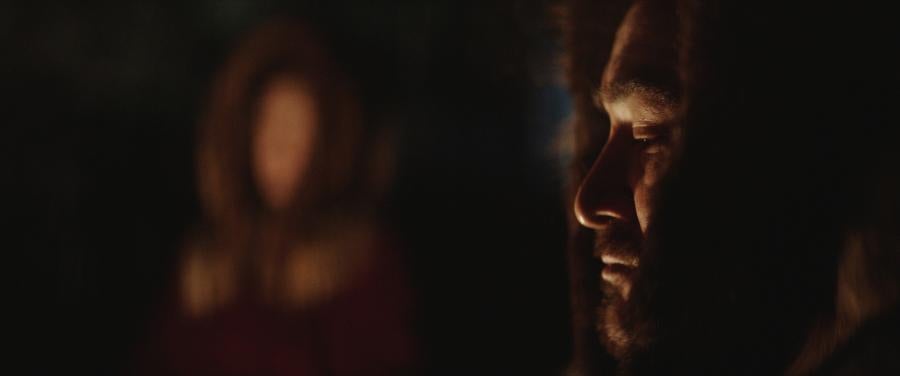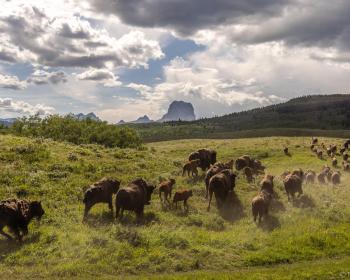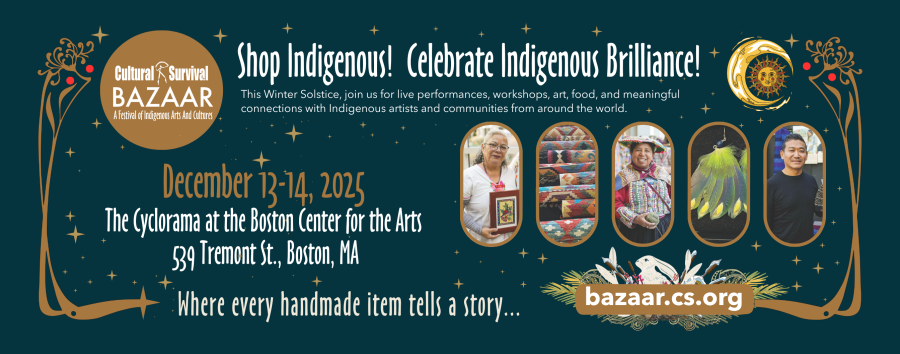
Photo courtesy of Navajo & Hopi Families COVID Relief.
Navajo Nation is one of the hardest-hit areas in the entire United States, with COVID-19 infection rates higher than everywhere but New York and New Jersey. Janene Yazzie (Diné), who works with International Indian Treaty Council as the Sustainable Development Coordinator, is the co-convener of the Indigenous Peoples Major Group for Sustainable Development. Today, she is the New Mexico lead for Navajo & Hopi Families COVID Relief, a grassroots organization that is working to combat the spread of the virus throughout both communities. Cultural Survival interviewed her recently about the impacts of the virus on Navajo Nation, as well as how the community has responded.
“This is the time when we really need to rise up and show solidarity,” she told Cultural Survival. “But we've been preparing for COVID-19 to hit our communities because we knew it would be bad, both because of the lack of access to healthcare, the lack of critical community infrastructure such as paved roads, water, utilities, electricity, and even just facilities that provide community services across our region. We knew that because of the digital divide that there would be, it would be hard to get accurate and timely information to people about how to deal with this. And we also knew that the federal response or the lack thereof prior to COVID coming down to the Southwest was also going to cause a lot of confusion because it was misleading people about the severity of the threat that we were facing. And so we started organizing before the first COVID case was detected on our nation.”
To respond to the crisis, Navajo & Hopi Families COVID Relief formed a network of collaboration between all kinds of actors. “We were trying to work early on with county, with Tribal government and with state government,” she said, “but what's really worked for us is not a formal partnership with those government agencies, but rather a really informal collaboration” between elected leaders, philanthropists, and other professionals. “We were able to bring a lot of the expertise that was necessary to the table to then address and look at and evaluate what were the gaps that an NGO could best fulfill knowing that on the government side.” This was made even more useful given that working with the government, and particularly the federal government, comes with “a lot of bureaucratic red tape” and “unnecessary barriers.” Moreover, organizing outside the government allows for greater flexibility—Navajo & Hopi Families COVID Relief can change their programs to meet the circumstances.
However, despite the advanced preparation done by Yazzie and her team, the disease was unavoidable. It “immediately created a hot spot because it was brought in by a non-Native pastor who was holding church services that brought members from different communities together...because that pastor was sick, he infected the majority of the churchgoers and those churchgoers then went back to their families, their households, their communities, and the way that our households are, they're multigenerational households...there can be up to 10 to 15 people living under one roof. Our families, we live with our elders, we take care of the grandkids. And so just that one event is what allowed this to really spark and start spreading like wildfire.”
This spread was only made worse by Navajo Nation’s rural nature. “Our reservation is the size of Connecticut, Wisconsin and New Hampshire combined,” she said, but “we only have eight health care facilities serving that entire area.” For example, when cases broke out in rural Chilchinbito, a symptomatic family had to travel hours by car to get to the Tuba City Regional Health Care Center, which didn’t even have tests; then, the family was transported six hours away to get tested. “All along that path, you also saw cases start to sprout up...all of the issues that existed prior to COVID getting here have just allowed it to spread like wildfire.”
However, Yazzie and her team knew that what she calls Navajo Nation’s “underdeveloped status” was exactly why organizing before the virus arrived was of the utmost importance: “not only did we understand that there were going to be particular vulnerabilities...that made our people more at risk, but also the impact that it was having on the economy was also going to disproportionately impact our people who are mostly wage laborers, or laborers that work in seasonal or contractual jobs, workers in the service industry, maids for hotels.” In addition to the high proportion of wage laborers on Navajo Nation, many are also involved in what is known as a “gray economy.” Yazzie describes it as an economy “where people make a lot of their money selling food on the roadside, or making crafts, or making things and selling them at big flea markets.” Both kinds of work, though, have been drastically shifted due to the coronavirus, putting most wage laborers and members of the gray economy out of work until the virus is controlled.
Because of the rapid rise in unemployment due to the pandemic, Yazzie told Cultural Survival how “food was the primary concern.” “We only have 13 grocery stores,” she said, “and so we are already dealing with some issues regarding lack of access to food...People were not going to be prepared or have the ability, either financially or in access to a grocery store to stock up on two weeks, three weeks worth of food in order to comply with the social distancing and self isolation rules that were going to protect them.” As such, the organizing work by Navajo & Hopi Families COVID Relief aimed “to stop working through the grocery stores and go directly to large suppliers and distributors to order food in bulk and have it delivered to different parts of our reservation, where our volunteers were trained in health and safety protocols, and we're outfitted in full PPE to then sort that into food boxes that we could provide to households.”
In addition to buying and distributing food, Navajo & Hopi Families COVID Relief is also supplying the community with things like feminine hygiene products, soap, and even diapers. “These are all things that would cause a person to go travel hours, to go to the nearest city in order to buy these things, because they’re not available anywhere to them locally.”
Now that Navajo & Hopi Families COVID Relief has designed a system to feed the community, they are working on reinvigorating the economy. “We’re...looking at how do we then compensate and invest in local farmers and ranchers and livestock owners through the donations that we're receiving so that we're buying directly from these small producers, therefore replacing the income that they lost from other revenue streams and open markets...We're going to be shifting our model more and more as this progresses to really look at not only providing the aid that will keep the household safe, but starting to support the beginnings of an economy that promotes local resiliency, that promotes local production, and self sustainability within each region, especially now that we are in planting season.”
What does Navajo & Hopi Families COVID Relief need in order to keep supporting the community? Simply put, money. “It takes a lot more work and energy to sort through” various types of food, books, and clothing, Yazzie told Cultural Survival. “It just takes up space or ends up taking more effort to get rid of the things that aren't needed...we really encourage people to just send cash,” because “if you really want to help communities that are impacted, you have to give them cash, because they know on the ground how best to use those resources.” For example, Yazzie recounted, “all of these cash donations is what allows us right now to have this conversation about buying directly from impacted farmers to then provide the food that goes out to these families, or investing and growing gardens as a long term strategy for how to deal with the food scarcity issues. If we didn't have donations of cash, we wouldn't be able to do that.”
Although Navajo & Hopi Families COVID Relief has stepped up in a major way to fill in the gaps created by the collapse of the economy and the failures of the federal government, the solution lies not in relief efforts but in rethinking the system within which the pandemic spread. “We need to build something better,” Yazzie concluded. “If there’s anything we’re learning from this, it’s that we deserve more, and we’ve got to build better, resilient economies and communities.”
To learn more about Navajo & Hopi Families COVID-19 Relief, visit: https://www.navajohopisolidarity.org/



